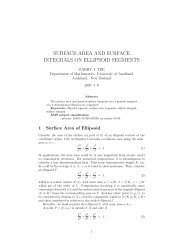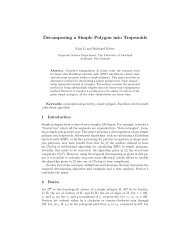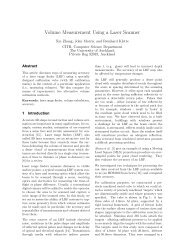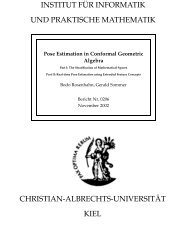Relative Convex Hull; MLP Approximation of Borders - CITR
Relative Convex Hull; MLP Approximation of Borders - CITR
Relative Convex Hull; MLP Approximation of Borders - CITR
Create successful ePaper yourself
Turn your PDF publications into a flip-book with our unique Google optimized e-Paper software.
Algorithmsfor Picture AnalysisLecture 18: Minimum-Length Polygons<strong>Convex</strong> <strong>Hull</strong>A set S is called convex if for any two points p, q <strong>of</strong> S the straightline segment pq is contained in S.The convex hull C(S) is the intersection <strong>of</strong> all <strong>of</strong> the halfspaces <strong>of</strong>R n that contain S; it is the smallest convex set that contains S.A convex polygon (polyhedron) is a nonempty bounded set that isan intersection <strong>of</strong> finitely many half-planes (half-spaces).A simple polygon (shaded, having 20 vertices) and its convexhull which is a simple polygon with 5 vertives.<strong>Convex</strong> hull <strong>of</strong> a finite set <strong>of</strong> points. – The calculation <strong>of</strong> convexhulls is a basic procedure in geometry-related picture analysis.Page 1 February 2005
Algorithmsfor Picture AnalysisLecture 18: Minimum-Length PolygonsGraham’s ScanR.L Graham (1972): O(n log n) for n points in R 21. Start at a point <strong>of</strong> S (called the pivot p) that is knownto be on the convex hull.2. Sort the remaining points p i <strong>of</strong> S in order <strong>of</strong> increasingangles η i ; if the angle is the same for more thanone point, keep only the point furthest from p. Let theresulting sorted sequence <strong>of</strong> points be q 1 , . . . , q m .3. Initialize C(S) by the edge between p and q 1 .4. Scan through the sorted sequence. At each left turn,add a new edge to C(S); skip the point if there isno turn (a collinear situation); backtrack at each rightturn.Left: angles η i for the vectors defined by q 1 , q 2 , q 5 , q 4 . Right:backtrack situation at q 6 ; the dashed edges are removed or notadded in Step 4 <strong>of</strong> the algorithm.Page 2 February 2005
Algorithmsfor Picture AnalysisLecture 18: Minimum-Length Polygons<strong>Relative</strong> <strong>Convex</strong> <strong>Hull</strong>J. Sklansky, R.L. Chazin, and B.J. Hansen in 1972Definition 1 Let S ⊆ B ⊂ R 2 . S is called B-convex iff, for allp, q ∈ S, if the straight line segment pq is in B, it is also in S. TheB-convex hull <strong>of</strong> S is the intersection <strong>of</strong> all B-convex sets that containS.<strong>Relative</strong> convex hulls. Left: A, B are simple polygons. Right:A, B are isothetic simple polygons.If A, B are simple polygons and A is contained in B, it can beshown that the frontier <strong>of</strong> the B-convex hull <strong>of</strong> A is the(uniquely determined) minimum-length polygonal curve (short:<strong>MLP</strong>) that is contained in B and that circumscribes A.<strong>Relative</strong> convex hulls are <strong>of</strong>ten used in robotics, computationalgeometry and picture analysis (digital geometry).Page 3 February 2005
Algorithmsfor Picture AnalysisLecture 18: Minimum-Length PolygonsLength in the 2D Cell Modelintrinsic distance between two points in a simple polygon = thelength <strong>of</strong> a shortest arc that connects the points and is containedin the polygonit follows: this is a polygonal arcintrinsic diameter <strong>of</strong> a polygon = the maximum intrinsic distancebetween any two <strong>of</strong> its pointsit follows: is between two vertices <strong>of</strong> the polygonLeft: the length <strong>of</strong> a simple 1-arc (in the 2D grid cell model) can bedefined by the length <strong>of</strong> its intrinsic diameterRight: the length <strong>of</strong> a simple 1-curve can be defined by the length<strong>of</strong> that <strong>MLP</strong> contained in the curve (to be precise: in the union <strong>of</strong>all 2-cells <strong>of</strong> this curve), and circumscribing its “inner frontier”Page 4 February 2005
Algorithmsfor Picture AnalysisLecture 18: Minimum-Length PolygonsLength in the 3D Cell ModelLeft: the length <strong>of</strong> a simple 2-arc (in the 3D grid cell model) can bedefined by the length <strong>of</strong> its intrinsic diameterRight: the length <strong>of</strong> a simple 2-curve can be defined by the length<strong>of</strong> that <strong>MLP</strong> that is uniquely identified by being contained in thecurve and not contractible into a single point within this curve.Difference between 2D and 3DIn the 2D case, the <strong>MLP</strong> coincides with the relative convex hull<strong>of</strong> the “inner frontier” with respect to the “outer frontier” (andthe design <strong>of</strong> a 2D <strong>MLP</strong> algorithm is not very hard). In the 3Dcase, there is no such analogy with a relative convex hull (andthe calculation <strong>of</strong> a 3D <strong>MLP</strong> within a simple 2-curve is a difficulttask).Page 5 February 2005
Algorithmsfor Picture AnalysisLecture 18: Minimum-Length Polygons1-Curve around a Digital Regionpicture grid on the left: a 4-region and its frontier (bold curve)frontier grid on the right: the original frontier runs through pixelsin this grid, and we consider these as being 2-cells; the originalfrontier defines this way a 1-curve, which is not simple ingeneral, but can be used as input for an <strong>MLP</strong> algorithmassuming that the successor <strong>of</strong> a 2-cell in this 1-curve defines theonly possible grid edge where the <strong>MLP</strong> can cross into a next2-cell (the figure on the right shows in bold grid edges whichare not allowed to cross)resulting <strong>MLP</strong>, approximating the frontier <strong>of</strong> the given 4-regionPage 6 February 2005
Algorithmsfor Picture AnalysisLecture 18: Minimum-Length PolygonsSelf-Intersectionswe illustrate possible self-intersections <strong>of</strong> the frontier <strong>of</strong> a givensimply-connected 4-regionAccordingly, the 1-curve <strong>of</strong> grid cells in the frontier grid,following a trace around the frontier, will also haveself-intersections. The <strong>MLP</strong>-algorithm needs to handle thesecases as well. The figure illustrates (upper row) the repeatedvisit <strong>of</strong> one 2-cell, and (lower row) the construction <strong>of</strong> the <strong>MLP</strong>in this case. The final result is shown at the bottom on the left.Page 7 February 2005
Algorithmsfor Picture AnalysisLecture 18: Minimum-Length PolygonsInner and Outer FrontierFollowing the given 1-curve in counter-clockwise orientation (ina righthand coordinate system), the sequence <strong>of</strong> 1-cells on theright form a 0-curve γ 1 <strong>of</strong> 1-cells (the “outer frontier” in case <strong>of</strong>a simple 1-curve), and those on the left a 0-curve γ 2 <strong>of</strong> 1-cells(the “inner frontier”).vertex v i on γ 1 or γ 2 is called a convex vertex if the frontier makesa positive turn at v i , detectable byD(v i−1 , v i , v i+1 ) > 0, where D is the determinantx 1 y 1 1x 2 y 2 1∣x 3 y 3 1∣ = x 1y 2 + x 3 y 1 + x 2 y 3 − x 3 y 2 − x 2 y 1 − x 1 y 3v i is called a concave vertex if the frontier makes a negative turn(D(v i−1 , v i , v i+1 ) < 0); a collinear vertex if D(v i−1 , v i , v i+1 ) = 0Our algorithm traces γ 1 (or γ 2 ), detects convex and concavevertices, puts their coordinates into a list L, and marks them asconvex or concave.For simplicity assume that the coordinates are integers; thecoordinates <strong>of</strong> two successive vertices with indices i and i + 1satisfy |x i+1 − x i | + |y i+1 − y i | = 1.Only convex vertices <strong>of</strong> the inner curve γ 2 and only concavevertices <strong>of</strong> the outer curve γ 1 can be vertices <strong>of</strong> the <strong>MLP</strong>.Page 8 February 2005
Algorithmsfor Picture AnalysisLecture 18: Minimum-Length PolygonsThere exists a mapping from the set <strong>of</strong> all concave vertices <strong>of</strong> γ 2onto the set <strong>of</strong> all concave vertices <strong>of</strong> γ 1 such that each concavevertex <strong>of</strong> γ 1 corresponds to at least one concave vertex <strong>of</strong> γ 2 .Numbers in the figure denote successive vertices in the list L:1 is a start vertex (i.e., an already known <strong>MLP</strong> vertex); 3 and 5are successive convex vertices on γ 2 ; 2, 4, and 6 are successiveconcave vertices on γ 1 . Vertex 7 is not between the negative(black line) and positive (white line) sides <strong>of</strong> sector (6,1,5);therefore 5 is the next <strong>MLP</strong> vertex and is a new start vertex.Start: put all <strong>of</strong> the vertices <strong>of</strong> γ 2 into L, then replace eachconcave vertex <strong>of</strong> γ 2 in L with its corresponding concave vertex<strong>of</strong> γ 1 by modifying its coordinates by ±1, where the signdepends on the orientations <strong>of</strong> the incident edges.L = all (plus others) <strong>of</strong> the vertices that will form the <strong>MLP</strong>Page 9 February 2005
Algorithmsfor Picture AnalysisLecture 18: Minimum-Length Polygons<strong>MLP</strong> calculation and calculation <strong>of</strong> its length L1. Initialize list L = (v 1 , . . . , v n ) as described above; itcontains all <strong>of</strong> the vertices on γ 2 except the concavevertices, which are replaced by concave vertices on γ 1 .Each v i in L is labeled by the sign <strong>of</strong> D(v i−1 , v i , v i+1 ).2. Let k := 1, a := 1, b := 1 and i := 2. Let L := 0 andp 1 := v 1 .//v 1 is the first <strong>MLP</strong> vertex//3. If i > n + 1, stop.4. If i ≤ n, then j := i; else j := 1. //go back to v 1 //5. If D(p k , v b , v j ) > 0, then //v j lies on the positiveside//{k := k + 1, p k := v b , i := b, a := b, and L :=L + d e (p k−1 , p k )};else(a) If D(p k , v a , v j ) ≥ 0, then //v j is in the sector//;if v j has a positive label, then b := j, else a := j;else //v j lies on the negative side//(b) {k := k + 1, p k := v a , i := a, b := a, and L :=L + d e (p k−1 , p k )}6. Let i := i + 1 and go to Step 3.The algorithm has linear time complexity.Page 10 February 2005
Algorithmsfor Picture AnalysisLecture 18: Minimum-Length PolygonsSuppose we already know that vertex v i <strong>of</strong> L is an <strong>MLP</strong> vertex.Then v j (j > i) can be an <strong>MLP</strong> vertex only if all convex verticesv + k such that i < k < j lie on the positive side <strong>of</strong> (v i, v j ) or arecollinear with it (i.e., D(v i , v + k , v j) ≥ 0).Similarly, all concave vertices v − lsuch that i < l < j must lie onthe negative side <strong>of</strong> (v i , v j ) or be collinear with it.Suppose a convex vertex v + and a concave vertex v − bothsatisfy these conditions. When we consider a vertex v as acandidate <strong>MLP</strong> vertex, the following situations can occur:1. v lies on the positive side <strong>of</strong> (v i , v + ) (i.e., D(v i , v + , v) ≥ 0);2. v lies on the negative side <strong>of</strong> (v i , v + ) or is collinear with itand also lies on the positive side <strong>of</strong> (v i , v − ) or is collinearwith it; or3. v lies on the negative side <strong>of</strong> (v i , v − ).In case (1), v + becomes the next <strong>MLP</strong> vertex.In case (2), v becomes a candidate for the <strong>MLP</strong> and must replaceeither v + or v − depending on the sign <strong>of</strong> v.In case (3), v − becomes the next <strong>MLP</strong> vertex. This is also correctin the trivial case where v + , v − , or both coincide with v i .Start: a vertex v 1 that is known to be an <strong>MLP</strong> vertex (e.g., theuppermost-leftmost vertex <strong>of</strong> γ 2 ); set v + and v − equal to v 1 ; andthen test all subsequent vertices as just described.Whenever the next <strong>MLP</strong> vertex is detected, it becomes a newstart vertex.Page 11 February 2005
Algorithmsfor Picture AnalysisLecture 18: Minimum-Length PolygonsCourseworkRelated material in textbook: Sections 1.2.9, 10.1.4, 10.2.3, and10.2.4.A.18. [7 marks] Implement the given <strong>MLP</strong> algorithm forestimating the perimeter <strong>of</strong> a simply-connected 4-region by thelength <strong>of</strong> the <strong>MLP</strong>. (The calculated length L defines the lengthestimator E mlp .) Note:http://www.citr.auckland.ac.nz/dgt/Source Code.php?id=4<strong>of</strong>fers a free download <strong>of</strong> an <strong>MLP</strong> source.Allow as input simply-connected 4-regions <strong>of</strong> arbitrary shapeand size in a 256 × 256 binary picture.(i) Test your algorithm by considering “extreme input cases”,such as shown below.(ii) Generate a diagram which shows run-times <strong>of</strong> youralgorithm in dependence upon the length <strong>of</strong> the frontier (note:this length is equal to the number <strong>of</strong> 1-cells on this curve) <strong>of</strong> thegiven 4-region.(iii) Optionally, [1 mark] also provide a way (e.g., in a grid <strong>of</strong>higher resolution) to visualize the calculated <strong>MLP</strong>.Page 12 February 2005







